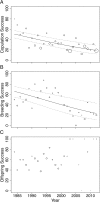Disentangling the mechanisms of mate choice in a captive koala population
- PMID: 30155356
- PMCID: PMC6108315
- DOI: 10.7717/peerj.5438
Disentangling the mechanisms of mate choice in a captive koala population
Abstract
Successful captive breeding programs are crucial to the long-term survival of many threatened species. However, pair incompatibility (breeding failure) limits sustainability of many captive populations. Understanding whether the drivers of this incompatibility are behavioral, genetic, or a combination of both, is crucial to improving breeding programs. We used 28 years of pairing data from the San Diego Zoo koala colony, plus genetic analyses using both major histocompatibility complex (MHC)-linked and non-MHC-linked microsatellite markers, to show that both genetic and non-genetic factors can influence mating success. Male age was reconfirmed to be a contributing factor to the likelihood of a koala pair copulating. This trend could also be related to a pair's age difference, which was highly correlated with male age in our dataset. Familiarity was reconfirmed to increase the probability of a successful copulation. Our data provided evidence that females select mates based on MHC and genome-wide similarity. Male heterozygosity at MHC class II loci was associated with both pre- and post-copulatory female choice. Genome-wide similarity, and similarity at the MHC class II DAB locus, were also associated with female choice at the post-copulatory level. Finally, certain MHC-linked alleles were associated with either increased or decreased mating success. We predict that utilizing a variety of behavioral and MHC-dependent mate choice mechanisms improves female fitness through increased reproductive success. This study highlights the complexity of mate choice mechanisms in a species, and the importance of ascertaining mate choice mechanisms to improve the success of captive breeding programs.
Keywords: Captive breeding; Genetic compatibility; Major histocompatibility complex (MHC); Male heterozygosity; Mate choice; Microsatellites.
Conflict of interest statement
The authors declare that they have no competing interests.
Figures



Similar articles
-
Demographic, environmental and genetic determinants of mating success in captive koalas (Phascolarctos cinereus).Zoo Biol. 2018 Nov;37(6):416-433. doi: 10.1002/zoo.21457. Epub 2018 Nov 29. Zoo Biol. 2018. PMID: 30488502
-
Seeing-good-gene-based mate choice: From genes to behavioural preferences.J Anim Ecol. 2019 Nov;88(11):1708-1719. doi: 10.1111/1365-2656.13071. Epub 2019 Aug 15. J Anim Ecol. 2019. PMID: 31332779 Free PMC article.
-
MHC class II-assortative mate choice in European badgers (Meles meles).Mol Ecol. 2015 Jun;24(12):3138-50. doi: 10.1111/mec.13217. Epub 2015 Jun 9. Mol Ecol. 2015. PMID: 25913367
-
Improving the sustainability of ex situ populations with mate choice.Zoo Biol. 2019 Jan;38(1):119-132. doi: 10.1002/zoo.21450. Epub 2018 Nov 26. Zoo Biol. 2019. PMID: 30474268 Review.
-
Why do females mate multiply? A review of the genetic benefits.Biol Rev Camb Philos Soc. 2000 Feb;75(1):21-64. doi: 10.1017/s0006323199005423. Biol Rev Camb Philos Soc. 2000. PMID: 10740892 Review.
Cited by
-
Modelling Genetic Benefits and Financial Costs of Integrating Biobanking into the Captive Management of Koalas.Animals (Basel). 2022 Apr 12;12(8):990. doi: 10.3390/ani12080990. Animals (Basel). 2022. PMID: 35454237 Free PMC article.
-
Deciphering genetic mate choice: Not so simple in group-housed conservation breeding programs.Evol Appl. 2020 May 19;13(9):2179-2189. doi: 10.1111/eva.12981. eCollection 2020 Oct. Evol Appl. 2020. PMID: 33005217 Free PMC article.
-
Low Diversity of Major Histocompatibility Complex (MHC) Genes in Endangered Malayan Tapir (Tapirus indicus).Zool Stud. 2023 Mar 31;62:e12. doi: 10.6620/ZS.2023.62-12. eCollection 2023. Zool Stud. 2023. PMID: 37187804 Free PMC article.
References
-
- Allen CD, De Villiers DL, Manning BD, Dique DS, Burridge M, Chafer ML, Nicolson VN, Jago SC, McKinnon AJ, Booth RJ, McKee JJ, Pyne MJ, Zee YP, Lundie-Jenkins G, Theilemann P, Wilson RJ, Carrick FN, Johnston SD. Seasonal reproduction in wild and captive male koala (Phascolarctos cinereus) populations in south-east Queensland. Reproduction, Fertility and Development. 2010;22(4):695–709. doi: 10.1071/RD09113. - DOI - PubMed
LinkOut - more resources
Full Text Sources
Other Literature Sources
Research Materials

